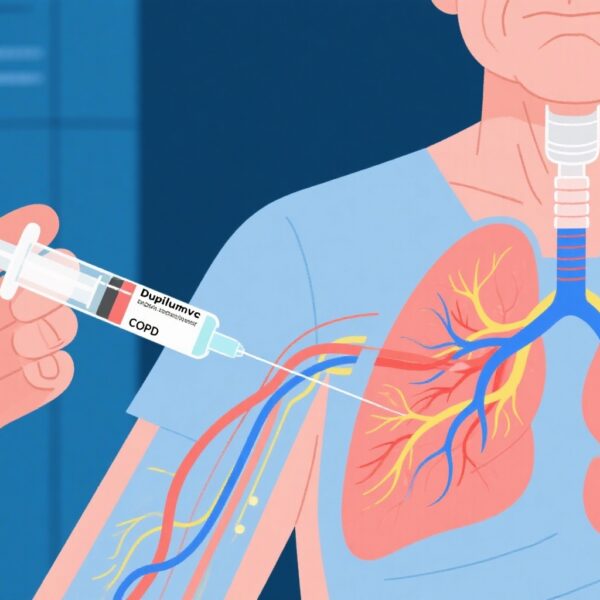Tổng quan
1. Liều thấp morphine kéo dài (20 mg/ngày) không làm thay đổi hiệu suất giấc ngủ hoặc tần suất các sự kiện rối loạn hô hấp trong giấc ngủ ở bệnh nhân mắc bệnh phổi tắc nghẽn mạn tính (COPD) gặp khó thở.
2. Morphine làm giảm tần suất hô hấp nhưng dẫn đến tăng hypoventilation ban đêm đáng kể, được chứng minh bằng nồng độ CO2 qua da cao hơn và nồng độ oxy thấp hơn.
3. Không có cải thiện về cảm giác khó thở chủ quan hoặc suy giảm khả năng lái xe mô phỏng vào ngày hôm sau.
4. Các tác dụng phụ, phổ biến nhất là buồn nôn, xuất hiện nhiều hơn khi sử dụng morphine, làm nổi bật các lo ngại về an toàn.
Nền tảng nghiên cứu và gánh nặng bệnh lý
Khó thở mãn tính ảnh hưởng sâu sắc đến bệnh nhân COPD, làm giảm chất lượng cuộc sống và chức năng hàng ngày. Các thuốc opioid như morphine liều thấp ngày càng được kê đơn ngoại nhãn để giảm khó thở không đáp ứng. Báo cáo lâm sàng và đánh giá chủ quan cho thấy morphine có thể điều chỉnh khó thở một phần thông qua cải thiện chất lượng giấc ngủ hoặc cơ chế liên quan đến giấc ngủ tinh tế. Tuy nhiên, bệnh nhân COPD dễ bị ức chế hô hấp và hypoventilation do opioid, đặc biệt là trong giấc ngủ, có thể làm trầm trọng thêm tình trạng thiếu oxy và tăng CO2. Dù có những lo ngại này, dữ liệu khách quan giải thích tác động của morphine liều thấp đối với sinh lý giấc ngủ và an toàn trong COPD vẫn còn ít. Điều này đã cản trở hướng dẫn rõ ràng về việc sử dụng opioid để giảm khó thở trong nhóm bệnh nhân này.
Thiết kế nghiên cứu
Nghiên cứu này là một thử nghiệm ngẫu nhiên, đôi mù, chéo được thực hiện trên 19 người lớn mắc COPD bị khó thở mãn tính, bao gồm 7 phụ nữ. Người tham gia nhận morphine kéo dài 20 mg mỗi ngày hoặc giả dược trong 3 ngày, sau đó có thời gian rửa trôi trước khi chuyển sang điều trị thay thế. Thời gian dùng liều ổn định nhằm phản ánh việc sử dụng morphine thường xuyên trong lâm sàng để kiểm soát triệu chứng. Điểm kết thúc chính là hiệu suất giấc ngủ, được đo bằng phương pháp polysomnography (PSG) ban đêm trong phòng thí nghiệm. Các điểm kết thúc phụ và thăm dò bao gồm tần suất các sự kiện rối loạn hô hấp trong giấc ngủ (ngừng thở/giảm thở), mức độ thấp nhất và trung bình của nồng độ oxy, mức độ CO2 qua da, các dấu hiệu sinh học máu, mối quan hệ giữa các thông số giấc ngủ và khó thở ban ngày, phản ứng hô hấp đối với tải trọng kháng lực bên ngoài, và hiệu suất nhận thức khách quan được đánh giá bằng mô phỏng lái xe vào ngày hôm sau. Các thông số dược động học và sinh lý được đánh giá trước và sau PSG. Nghiên cứu nhằm tận dụng việc định lượng kỹ lưỡng các động lực hô hấp và giấc ngủ để làm rõ các lợi ích và rủi ro tiềm ẩn của morphine liều thấp trong bối cảnh lâm sàng này.
Kết quả chính
Hiệu suất giấc ngủ: Kết quả chính—hiệu suất giấc ngủ—không có sự khác biệt đáng kể giữa nhóm morphine và nhóm giả dược (morphine: 67 ± 19% so với giả dược: 66 ± 17%; P = .89). Điều này cho thấy morphine liều thấp không làm tăng hoặc giảm tỷ lệ thời gian ngủ tổng thể ở bệnh nhân COPD gặp khó thở.
Rối loạn hô hấp trong giấc ngủ và mẫu hô hấp: Việc sử dụng morphine không làm thay đổi tần suất các sự kiện rối loạn hô hấp trong giấc ngủ mỗi giờ, cho thấy không có nguy cơ tăng của hội chứng ngừng thở/giảm thở trung ương hoặc tắc nghẽn dưới liều lượng này.
Tuy nhiên, morphine làm giảm đáng kể tần suất hô hấp tổng thể trong giấc ngủ. Hơn nữa, nồng độ oxy trung bình ban đêm giảm khoảng 2% (95% CI, -2.8% đến -1.2%) với morphine, và nồng độ oxy thấp nhất giảm 5% (95% CI, -8% đến -1%). Đồng thời, nồng độ CO2 qua da trung bình tăng 3.3 mm Hg (95% CI, 1.6-5.1 mm Hg), chỉ ra hypoventilation.
Nhóm nguy cơ hypoventilation: Số người tham gia đáp ứng tiêu chí của Học viện Hô hấp Hoa Kỳ cho hypoventilation ban đêm tăng gấp đôi khi sử dụng morphine (42%) so với giả dược (21%), một sự khác biệt có ý nghĩa thống kê (P = .02). Những phát hiện này nhấn mạnh hậu quả hô hấp có thể gây hại của morphine trong giấc ngủ ở bệnh nhân COPD.
Khó thở và sự tỉnh táo vào ngày hôm sau: Morphine không giảm khó thở chủ quan một cách hệ thống hay ảnh hưởng xấu đến hiệu suất mô phỏng lái xe vào ngày hôm sau, cho thấy lợi ích triệu chứng hoặc nhận thức hạn chế trong điều kiện nghiên cứu.
Tác dụng phụ: Nhóm morphine trải qua tần suất tác dụng phụ cao hơn, chủ yếu là buồn nôn, làm nổi bật thách thức về khả năng dung nạp ngay cả với điều trị opioid liều thấp.
Bình luận chuyên gia
Nghiên cứu này giải quyết một vấn đề lâm sàng quan trọng: cách cân nhắc giữa việc giảm khó thở và nguy cơ hô hấp khi sử dụng opioid trong COPD. Dữ liệu polysomnography khách quan đóng góp những hiểu biết mới rằng morphine liều thấp không cải thiện cấu trúc giấc ngủ hoặc giảm các sự kiện hô hấp, nhưng lại gây ra nguy cơ hypoventilation rõ ràng. Sự ức chế hô hấp trong giấc ngủ có thể làm trầm trọng thêm tình trạng giữ CO2 mãn tính và thiếu oxy, gây ra lo ngại về an toàn mà phải cân nhắc khi sử dụng opioid trong nhóm bệnh nhân này.
Việc không cải thiện khó thở chủ quan trái ngược với một số báo cáo không kiểm soát trước đây, cho thấy lợi ích triệu chứng của morphine có thể ít vững chắc hoặc đa dạng hơn. Đáng chú ý, sự tỉnh táo và chức năng tâm vận động vào ngày hôm sau được bảo tồn, giảm bớt một phần lo ngại về tác dụng sedation còn sót lại ở liều lượng được nghiên cứu.
Các hạn chế bao gồm kích thước mẫu nhỏ và thời gian điều trị ngắn, hạn chế kết luận về an toàn và hiệu quả lâu dài. Thiết kế chéo là một điểm mạnh về phương pháp, giảm thiểu sự biến đổi giữa cá nhân. Các nghiên cứu tương lai nên khám phá các nhóm bệnh nhân, mối quan hệ liều-lượng, và tích hợp các chiến lược quản lý khó thở đa phương thức.
Các bác sĩ phải cân nhắc kỹ lưỡng các phát hiện này đối với nhu cầu lâm sàng, xem xét các phương pháp điều trị thay thế và theo dõi chặt chẽ khi kê đơn opioid cho bệnh nhân COPD.
Kết luận
Tóm lại, thử nghiệm chéo ngẫu nhiên này cho thấy morphine kéo dài liều thấp không thay đổi hiệu suất giấc ngủ hoặc tần suất rối loạn hô hấp trong giấc ngủ ở bệnh nhân COPD, nhưng làm tăng đáng kể hypoventilation ban đêm và giảm nồng độ oxy. Không có cải thiện triệu chứng khó thở hoặc suy giảm sự tỉnh táo ban ngày, trong khi các tác dụng phụ như buồn nôn xuất hiện nhiều hơn. Những kết quả này đòi hỏi phải cẩn trọng khi kê đơn opioid để điều trị khó thở mãn tính trong COPD, nhấn mạnh cần cân nhắc giữa khả năng giảm triệu chứng và nguy cơ an toàn hô hấp trong giấc ngủ. Cần thêm các thử nghiệm quy mô lớn và nghiên cứu cơ chế để tối ưu hóa các chiến lược quản lý cho triệu chứng này.
Tham khảo
Altree TJ, Pinczel AJ, Toson B, Loffler KA, Hudson AL, Zeng J, Proctor S, Naik G, Mukherjee S, Catcheside P, Somogyi A, Currow DC, Eckert DJ. The Effects of Low-Dose Morphine on Sleep and Breathlessness in COPD: A Randomized Trial. Chest. 2025 Jun;167(6):1578-1590. doi:10.1016/j.chest.2024.11.040. Epub 2024 Dec 13. PMID: 39675518.
Văn献 liên quan khác:
Currow DC, McDonald C, Oaten S, et al. Once-daily opioids for chronic breathlessness: a dose increment and pharmacovigilance study. Eur Respir J. 2013;42(6):1574-1583.
Ekström M, Bajwah S, Bland JM, et al. Safety of benzodiazepines and opioids in very severe respiratory disease: national prospective study. BMJ. 2014;348:g445.
American Academy of Sleep Medicine. International Classification of Sleep Disorders, 3rd ed. Darien, IL: AASM; 2014.



